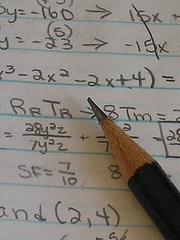Every so often, at around 7:00 p.m., I’ll get a call from someone I know. “I don’t understand my kid’s math homework,” they’ll say.
These folks aren’t dumb or bad at math. But almost always, they’ve hit a concept that they used to know, but don’t remember any more. And those things can trip them up — big time. So, I thought it might be helpful to review 4 middle school math facts that may give parents trouble.
Every number has two square roots.
This is the question that prompted this blog post. I got a call from a friend who didn’t understand this question in her daughter’s math homework: “Find both square roots of 25.” Both?
Most adults have probably forgotten that each number has two square roots. That’s because we are typically only interested in only one of them — the positive one.
Yep, the square roots of 25 are 5 and -5. In other words:
sqrt{25} = 5 and -5
It should be pretty easy to see why this is true. (You just have to remember that when you multiply two negative numbers, your answer is positive.)
5 · 5 = 25
-5 · -5 = 25
1 is not prime.
This question came up in my own daughter’s homework last week — a review of prime and composite numbers. Remember, prime numbers have only two factors, 1 and the number itself. So, 7 is prime. And so are 13, 19 and even 3. But what about 1?
Well, it turns out the definition of a prime number is a little more complicated than what we may assume. And I’m not even going to get into that here.
But there is a way for less-geeky folks to remember that 1 is not prime. Let’s look at the factors of each of the prime numbers we listed above:
7: 1, 7
13: 1, 13
19: 1, 19
3: 1, 3
Now, what about the factors of 1?
1: 1
Notice the difference? Prime numbers have two factors, 1 and the number itself. But 1 only has one factor.
0 is an even number.
This idea seems to trip up teachers, students and parents. That’s because we tend to depend on this definition of even: A number is even, if it is evenly divisible by 2. How can you divide 0 into two equal parts?
It might help to think of the multiplication facts for 2:
2 x 0 = 0
2 x 1 = 2
2 x 2 = 4
2 x 3 = 6 …
All of the multiples of 2 are even, and as you can see from this list, 0 is a multiple of 2.
Anything divided by 0 is undefined.
Okay, this gets a little complex, so bear with me. (Of course, if you want, you can just memorize this rule and be done with it.)
First, we can describe division like this:
r={a/b}
Using a little bit of algebra you can get this:
r · b = a
So, what if b = 0?
r · 0 = a
That only works if a is also 0, and 0 ÷ 0 gives us all kinds of other problems. (Trust me on that. This is where things get pretty darned complicated!)
So how many of you have thought while reading this, “I will never use this stuff, so what’s the point?” You may be right. Knowing that 0 is an even number is probably not such a big deal. But at least your kid will think you’re extra smart, when you can help him with his math homework.
What are your math questions? Is there anything that’s been bugging you for ages that you still can’t figure out? Ask your questions in the comments section. I’ll answer some here and create entire posts out of others.
